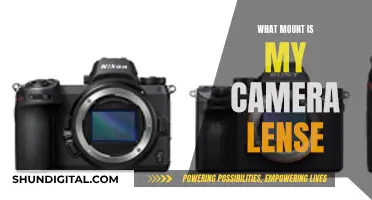
Lenses are an essential component of cameras. They play a crucial role in manipulating and focusing light to produce images on the camera's sensor. The lens's aperture controls the volume of light passing through it, with larger apertures allowing more light to enter. The focal length of a lens determines its angle of view and magnification, with shorter focal lengths providing a wider field of view and longer focal lengths offering a narrower, more zoomed-in perspective. Lenses can be interchangeable, allowing photographers to choose the ideal lens for their specific needs, or they can be permanently fixed to the camera. The quality of the lens greatly affects the resulting image, with high-quality lenses capable of capturing vibrant and detailed images even with cheaper cameras.
| Characteristics | Values |
|---|---|
| Purpose | Capture images of objects on photographic film or other media |
| Function | Manipulate light to produce images on a camera's sensor |
| Focal Length | Determines the lens's angle of view and magnification |
| Aperture | Controls the volume of light permitted through the lens |
| Image Quality | Affected by optical aberrations, vignetting, and distortion |
| Lens Speed | Refers to the maximum aperture of the lens |
| Weight | Varies depending on the lens type and purpose |
| Size | Varies depending on the lens type and purpose |
| Cost | Varies depending on features and quality |
What You'll Learn
- Lenses manipulate light to produce images on a camera's sensor
- A lens's aperture governs the volume of light permitted through it
- The focal length of a lens determines its angle of view
- Lens aberrations occur when points in the image do not translate back to single points after passing through the lens
- The lens mount ensures the lens fits securely to the camera body

Lenses manipulate light to produce images on a camera's sensor
Lenses are an essential component of a camera, and their role goes beyond mere optics. They are the single most important part of a camera, even more so than the camera body. The lens's primary function is to manipulate light to create images on the camera's sensor. This process involves several steps, and each step is meticulously carried out by the lens.
Firstly, the lens acts as a net, gathering and channelling light rays into the camera. The quality of the lens determines the amount of light captured, with better lenses allowing for more vibrant and detailed images. This is a crucial step as it forms the foundation for the image that will be produced.
The next step is focusing. The lens adjusts its glass elements to ensure the image's subject is clear and well-defined, creating a crystal-clear focal point. This is achieved by adjusting the lens's glass elements to bring the image into sharp focus. The lens's optical centre, or "nodal point", is where the light rays converge before forming an image on the camera's sensor.
The lens also plays a crucial role in refraction, bending and shaping light to guide it in forming the image. Additionally, it controls dispersion, ensuring that light is spread into various colours without causing unintended colour fringes in the final image.
The focal length of the lens is another critical factor. It is the distance between the lens's optical centre and the camera's sensor when focused at infinity. Focal length determines the lens's angle of view and how "zoomed in" the resulting image appears. A short focal length captures a wide field of view, making it ideal for landscapes, while a long focal length provides a narrower view, perfect for isolating subjects.
The aperture of the lens is also important. It refers to the amount the lens can open or close to let in more or less light, respectively. Aperture settings provide artistic flexibility in terms of exposure options and depth of field. A wider aperture, often associated with a smaller f-number, lets in more light and facilitates a shallower depth of field, resulting in a creamy, out-of-focus background. Conversely, a narrower aperture provides a deeper depth of field, keeping more of the scene in sharp focus.
In summary, the lens plays a pivotal role in the camera's functionality, from gathering light to focusing and manipulating it to create clear, vibrant images. Its various components and settings, such as focal length and aperture, offer photographers creative control over their craft, making it possible to capture the world in a multitude of ways.
Understanding Camera Lenses: Decoding the Specs
You may want to see also

A lens's aperture governs the volume of light permitted through it
The aperture of a lens works in a similar way to the pupil in the human eye, contracting in bright conditions and expanding in low-light environments to achieve the correct exposure. This adjustment is made by an array of aperture blades in the lens that move synchronously to control the size of the aperture.
The aperture also affects the depth of field in an image, which is the distance between the nearest and furthest objects in a scene that appear sharp. A wider aperture results in a shallower depth of field, with only a small area of the image in sharp focus. This can be useful for isolating the subject from the background, such as in portrait photography. Conversely, a narrower aperture will result in a greater depth of field, with more of the image appearing sharp, which is ideal for landscape and architecture photography.
In addition to aperture, shutter speed and ISO settings also impact the exposure of an image. Shutter speed controls the duration of light hitting the sensor, while ISO sets the camera sensor's sensitivity to light. Together, these three elements form the Exposure Triangle, and mastering the balance between them is key to achieving the desired exposure.
Lens Compatibility: How to Identify Camera Lens Brands
You may want to see also

The focal length of a lens determines its angle of view
The role of a camera lens is to focus light into the back of the camera, through the viewfinder, and onto the camera's sensor or film. Without a lens, a camera is useless to a photographer. The lens plays a critical role in determining image quality.
The focal length of a lens is the distance between the camera sensor and the lens's optical centre, which is the point where light rays converge within the lens. The focal length determines the lens's field of view and magnification or zoom capabilities. It is typically measured in millimetres.
A longer focal length will result in a narrower angle of view, while a shorter focal length will yield a wider angle of view. This is because the focal length defines the angular field of view (AFOV). For a given sensor size, a shorter focal length will produce a wider AFOV. The relationship between focal length and AFOV can be calculated using the formula:
AFOV = 2 x tan^-1 (H / 2f)
Where 'H' is the sensor size and 'f' is the focal length.
The angle of view (AOV) describes the angular extent of a scene that is imaged by a camera. It is influenced not only by the focal length of the lens but also by the size of the camera's sensor. Digital sensors are usually smaller than 35mm film, resulting in a narrower angle of view for the same lens. This effect is described by the crop factor.
For lenses projecting rectilinear (non-spatially distorted) images of distant objects, the effective focal length and image format dimensions completely define the angle of view. The formula for calculating the angle of view (α) is:
Α = 2 x arctan (d / 2f)
Where 'd' represents the size of the film or sensor in the direction measured, and 'f' is the effective focal length.
Recognizing Camera Lenses: A Beginner's Guide to Identification
You may want to see also

Lens aberrations occur when points in the image do not translate back to single points after passing through the lens
Lenses play a crucial role in cameras, converging light onto the image sensor or film plane to produce an image. The quality of the lens greatly affects the resulting image; a high-quality lens can help capture great photos, while a low-quality lens can make even the best camera mediocre.
Lens aberrations are imperfections in the way a lens focuses light, and they occur when points in the image do not translate back to single points after passing through the lens. Light enters the lens as waves, and ideally, all the waves would converge at the same point. However, aberrations occur when light waves converge at different points, affecting sharpness, colour, and even the shape of light in the image.
There are two main types of lens aberrations: chromatic and monochromatic. Chromatic aberrations occur when a lens cannot focus all colours to the same point, resulting in colour fringing where dark and light regions meet. This is caused by the different colours of light moving at different speeds through the glass of the lens. Monochromatic aberrations, on the other hand, are optical distortions created by white light passing through the lens at different speeds and angles.
Monochromatic aberrations include spherical aberration, where light entering at the edges of the lens hits the optical axis at a different point than light entering in the centre, creating a soft-focus effect. Another type is coma or comatic aberration, which is similar to spherical aberration but results in an elongated distortion, like the shape of a comet.
Curvature distortions are another common issue, with two main types: barrel and pincushion. Barrel distortion causes the centre of the image to bulge, appearing smaller at the edges, as if wrapped around a barrel. Pincushion distortion, on the other hand, causes the centre to pucker inward, making the image look larger at the edges. Some lenses exhibit both types of distortions, resulting in a complex wave-like distortion known as moustache distortion.
Lens aberrations can have artistic value and are sometimes intentionally included in images. However, they can also be distracting if the goal is to represent a scene faithfully. Lens manufacturers work continuously to correct and minimise these aberrations, using various techniques and additional lens elements to improve image quality.
The Ultimate Guide to Listing Camera Lenses Like a Pro
You may want to see also

The lens mount ensures the lens fits securely to the camera body
The lens mount is an essential component of a camera, ensuring the lens is securely attached to the camera body and enabling seamless functionality and compatibility. It acts as an interface, connecting the camera body and the lens through mechanical and, in some cases, electrical means.
The lens mount plays a pivotal role in determining the compatibility of the camera system. Different camera brands often have their own proprietary lens mount designs, which are typically incompatible with other manufacturers' products. This specificity in design ensures that lenses fit securely and function optimally with their corresponding camera bodies.
There are various types of lens mounts, each with its own unique features and compatibility. Some common types include bayonet mounts, screw-threaded mounts, and breech-lock (friction lock) mounts. Modern still camera lens mounts predominantly use the bayonet mount system, which offers precise alignment of mechanical and electrical features between the lens and the camera body.
The lens mount not only ensures a secure connection but also facilitates the transfer of electronic signals and enables autofocus and aperture control. This electronic communication between the camera body and the lens is a crucial aspect of modern photography and cinematography.
Additionally, the lens mount allows for the interchangeability of lenses, providing photographers and filmmakers with the flexibility to choose the most suitable lens for their specific needs. This interchangeability empowers users to experiment with different focal lengths, apertures, and other lens properties, ultimately enhancing their creative capabilities and the overall quality of their images and videos.
Blackmagic Pocket Camera 4K: Lens Options Explored
You may want to see also
Frequently asked questions
A camera lens is an assembly of lenses that is mounted onto the camera. Some lenses are permanently fixed, while others can be swapped out.
Camera lenses manipulate light to produce images on a camera's sensor. They channel and focus light, and adjust their glass elements to perfect the image's focus.
The focal length of a lens is the distance between its optical centre and the camera's sensor when the lens is focused at infinity. It determines the lens's angle of view and how "zoomed in" your photos appear.
Zoom lenses offer a range of focal lengths, allowing you to adjust the zoom without changing the lens. Prime lenses have a fixed focal length. Zoom lenses offer more flexibility in composition, while prime lenses are often sharper, have a larger aperture, and are more lightweight.
The aperture of a camera lens refers to the amount the lens can open or close to let in light. It is listed in terms of f-numbers, which describe the relative light-gathering area. A larger aperture (lower f-number) allows more light to enter and creates a shallower depth of field, resulting in a blurred background.







